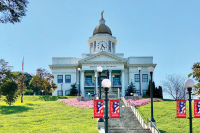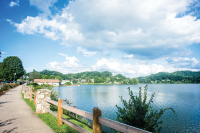Kephart proved to be a key figure in shepherding idea of a national park
With massive logging operations running full tilt in the Smokies in the 1920s, the sanctity of what once seemed like a vast and untouchable forest was being rapidly reduced to a desert of stumps.
While most locals welcomed the money brought in by timber barons, the famed writer Horace Kephart saw the crash waiting on the other side of the short-lived boom, the day when the trees would be gone and the timber companies would move out, leaving the locals not only without jobs once more, but without the forests their subsistence depended on.
Kephart moved to the region in the early 1900s and immersed himself in the culture of backwoods mountaineers, who he later immortalized in his famed Our Southern Highlanders. It was natural that Kephart recoiled to see his old stomping grounds of Hazel Creek in Swain County ripped to shreds and the landscape denuded.
“He was heartbroken about it. He thought it was a rape. It was going on right where he had lived,” said George Ellison, a leading Kephart scholar in Bryson City.
The contempt came out in Kephart’s writing.
“He wrote that their machinery frightened him, it seemed almost animate and alive as it crawled up the mountain destroying everything in its way with grease and smoke and fire,” said Gary Carden, a writer and historian well versed on Kephart. “He said ‘We have to stop it or it is all going to be gone. People I am living with don’t realize that this country is limited and they are using it up and nobody is stopping them.’ So he took on the job of making the world aware of what was happening in Appalachia.”
Related Items
The idea for a national park had been percolating quietly for more than a decade, but now Kephart seized on it.
“Every moment of his waking life from the mid-1920s to his death (in 1931) was devoted to that cause,” Ellison said. “He had a public persona and he used that to save what he was devoted to.”
Kephart propelled the idea of a national park like no one else could have. He cranked out magazine articles and newspaper columns across the nation. He penned personal letters to politicians and philanthropists. He joined the national park committee and wrote the text of brochures to promote the idea locally.
His writing was eloquent and his pitch was heartfelt, witnessed in this passage from a column that appeared in the Asheville Times.
“When I first came into the Smokies the whole region was one of superb primeval forest. My sylvan studio spread over mountain after mountain, seemingly without end, and it was always clean and fragrant, always vital, growing new shapes of beauty from day to day. The vast trees met overhead like cathedral roofs. I am not a very religious man, but often when standing alone before my Maker in this house not made with hands I bowed my head with reverence and thanked God for His gift of the greatest forest to one who loved it,” Kephart wrote. “Not long ago, I went to that same place again. It was wrecked, ruined, desecrated, turned into a thousand rubbish heaps, utterly vile and mean.”
Kephart likely would have preferred the job of writing behind the scenes, but he was pressed into service to go on the stump as well. Kelly Bennett, whose drug store in Bryson City served as makeshift headquarters for the pro-park movement, bought Kephart a proper suit to wear on a trip to Washington, D.C.
A Kephart critic on other fronts, outdoor writer and Bryson City native Jim Casada finds redemption in Kephart’s role as a “progenitor of the park.”
“His writings carried the concept to the nation. He was doing that in a sense even before the idea of the park’s creation was being bandied about,” Casada said.
Kephart unknowingly laid the groundwork for the park’s creation with Our Southern Highlanders. The book romanticized the region and captured the country’s imagination with a primitive “world apart” within the borders of their own continent.
The national park wouldn’t just preserve the wilderness, but the lifestyle borne from it.
Shaping a strategy
Kephart motivated the nation under the banner of environmental preservation, but his pitch to locals took a different tack: economic prosperity.
“There is a tourist industry coming. Help us save this and you will be the Gateway of the Smokies,” was Kephart’s pitch, says Carden. “Everybody thought they would be the Gateway to the Smokies.”
Carden doesn’t think the tourist industry blossomed as people were promised, at least not in Bryson City, and some held that against Kephart.
It’s impossible to know whether the Smokies would be here today if not for Kephart. Ellison thinks so, but it would have been far more difficult without the famed author as a spokesman.
There are hints that Kephart grew weary of the fight. In a letter to his son before he died, he described the undertaking as “beset with discouragements of all sorts.” The park’s creation was a certainty by then, and Kephart declared victory in the letter. He added that he would “get out” when the work was done.
Exactly what he meant is a mystery to this day, but Ellison believes Kephart wanted to return to a reclusive life filled with camping and woodcraft.
“It must have been exhausting to him to get involved in a project of that sort,” Ellison said.
Kephart had a secret weapon that kept him going, a friend by the name of George Masa, a nature photographer. Together, they fought for the Smokies: Masa through his stunning photos and Kephart through his writing. They went on long camping adventures through the mountains, mapping peaks and valleys as they went.
“Having somebody to work with, it gave him focus,” Ellison said.
Kephart died in 1931 in an automobile accident outside Bryson City. Kephart hired a taxi driver to take him and a visiting novelist, author of Bloody Ground Fiswoode Tarlton, to the home of a moonshiner. The driver, who likely partook in the goods himself, wrecked the car coming home, killing both Kephart and Tarlton.
A peak in the Smokies was named after Kephart, as was a creek at its base called Kephart Prong.
“He died knowing the park would be a reality,” Ellison said.
While the debate over Kephart’s depiction of the mountaineers will never be settled, he’s been forgiven for his role in creating the park.
“Very gradually, what you do have among a certain number of people in Bryson City is a grudging acknowledgement that Horace had done a good thing, that the creation of the park was a good thing, that it was trading a minor tragedy for a greater good,” Carden said. “They lost their land, but Kephart created a park that was there for all posterity. It’s hard to say when it happened to you, but finally a lot would say he was right. He did a good thing.”









